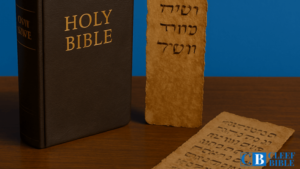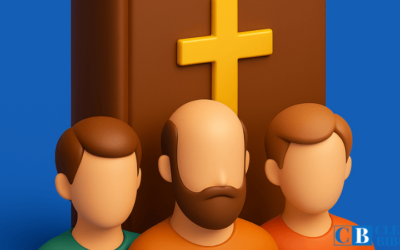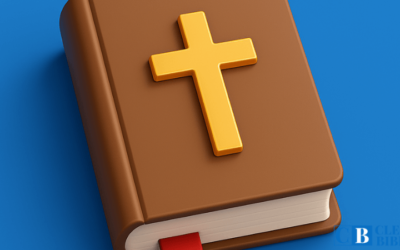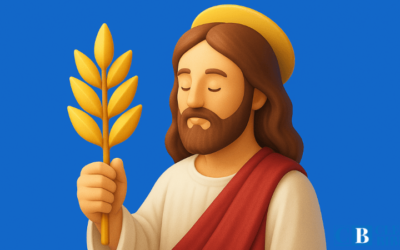Is there really an object capable of representing the presence of God and bringing down entire armies with just a touch?
From the pages of the Old Testament to modern myths, the Ark of the Covenant has captivated the minds of believers, archaeologists, and writers.
But what exactly was this enigmatic sacred chest?
What did it contain, what was its function, and why did it mysteriously disappear?
Throughout biblical history, the Ark was not only a symbol of divine covenant, but also an instrument of supernatural power, awe, and profound worship.
In this article, we'll explore its origin, purpose, content, demise, and spiritual legacy to this day... What if its meaning goes far beyond what we can imagine?
What is the Ark of the Covenant and why is it so significant?
Can an object contain the presence of God? The Ark of the Covenant was not just a sacred chest: it was the visible symbol of the covenant between God and his people. According to the Bible, it was designed by divine order, built by Moses in the desert, and placed in the most sacred place of the Tabernacle and later in Solomon's Temple.
This object not only housed the tablets of the Law, but rather represented the throne of God on earth, where heaven met humanity. Its importance lies in the fact that it was the heart of the Israelite cult, the epicenter of worship, the guide in times of war and the place of reconciliation.
Its mention in the Bible and its symbolic power
The Ark appears more than 200 times in Scripture, from Exodus to Revelation.
- In Exodus, it is the center of the Tabernacle.
- In Joshua, he opens the passage through the Jordan.
- In 1 Samuel, he defeats the Philistines without lifting a sword.
- In Kings and Chronicles, she is enthroned in the temple.
- In Revelation 11:19, it appears in the sky, indicating its eschatological dimension.
Beyond its physical appearance, the Ark embodies profound concepts:
- The holiness of God
- He judgment and mercy
- The divine alliance with human beings
Mysteries and fascination in history and culture
From its mysterious disappearance to its depiction in movies and conspiracy theories, the Ark of the Covenant has sparked a fascination that transcends time and religionWas it hidden before the exile? Is it under the Temple Mount? Is it guarded in Ethiopia?
The cinema, as in Indiana Jones, has contributed to this modern fascination, but the root of this interest is spiritual: the human longing for the divine, the eternal and the sacred.
The Ark remains one of the most powerful symbols in the Bible., with profound lessons for those seeking to understand the character of God and his relationship with humanity.
Origin and design of the Ark according to the Bible
Instructions given to Moses at Sinai
The origin of the Ark of the Covenant dates back to a moment of unique communion between God and Moses on Mount Sinai. According to Exodus 25:10-22, God himself gave detailed instructions for its construction as part of the Tabernacle, the mobile sanctuary of the people of Israel in the desert.
The Ark was not a human invention, but a divinely revealed celestial model, designed to reflect the holiness, order, and presence of God among his people.
It was the first object that God ordered to be made from the sacred furniture, which indicates its central priority in Israelite worship.
Dimensions, materials and symbolism of gold
The Ark was to measure two and a half cubits long, one and a half cubits wide, and one and a half cubits high (approximately 113cm x 68cm x 68cm).
It was made of acacia wood, a symbol of durability and resistance, and completely covered in pure gold inside and out, reflecting the perfection, purity and glory of God.
It had four gold rings for inserting poles, also made of gold-plated wood, for transport. This indicated that the Ark was not to be touched directly, remembering the sanctity of the object.
The use of gold, the most precious material in antiquity, communicated that this chest was a divine treasure, reserved exclusively for the God of Israel.
The Mercy Seat and the Cherubim: Theological Significance
A lid called the "Shrine" was placed over the Ark. propitiatory (capor in Hebrew), also made of pure gold. At the ends of this lid were carved two cherubs, angelic figures with outstretched wings looking at each other and covering the mercy seat.
This place was considered the invisible throne of God on earth, where He was manifested between the cherubim (Exodus 25:22). Each year, the high priest sprinkled blood on the mercy seat during the Day of Atonement (Leviticus 16), as an act of reconciliation between God and the people.
Theologically, the mercy seat prefigures Christ as the meeting place between justice and mercy, and the cherubs symbolize the celestial presence that guards the sacred.
The design of the Ark, in every detail, pointed to a larger reality: the need for atonement, the majesty of God and his desire to dwell among men.
Contents of the Ark of the Covenant
The Tablets of the Law: Divine Covenant
Inside the Ark of the Covenant were the stone tablets engraved with the Ten Commandments, given directly by God to Moses on Mount Sinai (Exodus 25:16; Deuteronomy 10:2). These tablets represented the heart of the covenant between God and Israel, a divine contract that established how the people should live in order to walk in communion with their Creator.
His presence in the Ark symbolized that The law of God was at the center of the spiritual life of the people. It was not a mere moral code, but the expression of divine will, remembering that Obedience was an essential part of the relationship with God.
Aaron's rod that budded
Another object kept in the Ark, according to Hebrews 9:4 and Numbers 17, was the Aaron's rod that miraculously blossomedThis event occurred when some of the tribes of Israel questioned Aaron's priestly authority. God ordered that the rods of each tribal leader be placed in the Tabernacle, and only Aaron's. It turned green, sprouted, blossomed, and bore fruit in one night.
This miracle confirmed that God had sovereignly chosen the house of Levi for the priesthood, and that his authority should not be disputed.
The rod inside the Ark symbolizes:
- The divine choice without discussion
- The life that springs from the power of God
- The legitimate priesthood and its connection to the divine presence
Manna: Supernatural Provision in the Desert
God also commanded that it be placed a vessel with manna in the Ark as a testimony for future generations (Exodus 16:33-34; Hebrews 9:4). The manna was the miracle food who came down from heaven and sustained the people of Israel during their journey through the desert for 40 years.
This symbol reminded us that:
- God is the faithful provider at all times
- Dependence on heaven is safer than any human resource
- Daily obedience to the Word nourishes both body and soul.
All in all, the contents of the Ark were much more than holy relics: it was a Tangible testimony of God's power, provision, authority, and covenant with his peopleEach element pointed to an eternal truth that remains valid today: The presence of God brings law, life, and sustenance to the obedient heart.
The role of the Ark in the desert and the conquest
Its location in the Tabernacle
During the journey through the desert, the Ark of the Covenant occupied the most sacred place in the world. Tabernacle: he Holy of Holies, separated from the rest by a thick veil (Exodus 26:33). Only the high priest was allowed to enter once a year, on the Day of Atonement, and then only with blood to make intercession for the people (Leviticus 16).
Thence, the glory of God was manifested between the cherubim of the Ark (Exodus 25:22). The Ark was not only a sacred piece of furniture, but the meeting point between heaven and earth, a visible sign that God walked with his people.
How he guided the people on their journeys
When the people of Israel embarked on a new journey in the desert, the Ark went before them, carried by the Levites (Numbers 10:33-36). Moses even said a prayer each time the Ark was moved:
“Arise, O Lord, and let your enemies be scattered; and let those who hate you flee from your presence.” (Numbers 10:35).
The Ark not only symbolized the divine presence, but also He marked the way, directed the order of march and guaranteed victory and protectionThis taught that spiritual direction should not depend on human logic, but on divine guidance.
Crossing of the Jordan and fall of the walls of Jericho
Two of the most impressive episodes where the Ark played a central role were:
- The crossing of the Jordan River (Joshua 3): When the priests carrying the Ark put their feet in the water, the river stopped dead and the people crossed on dry land into the Promised Land. The Ark paved the way where there was none, showing that God was going ahead as a conqueror.
- The fall of the walls of Jericho (Joshua 6): In divine strategy, the Ark was carried in procession around the city for seven days, accompanied by trumpets and silence. On the seventh day, as the trumpets sounded and the people shouted, The walls fell without physical combat, demonstrating that Victory comes through obedience to God's presence, not through military force.
At each stage of the journey to the Promised Land, the Ark taught an essential truth:
Wherever God's presence is, there is direction, provision, and supernatural victory. Without it, the people could not move forward.
Today, his message remains relevant: Don't take a step without the presence of God guiding your path.
The Ark in the time of the judges and kings
The capture of the Ark by the Philistines
During the period of the judges, when the people of Israel were in constant spiritual instability, the Ark was recklessly taken onto the battlefield as a kind of amulet to ensure victory against the Philistines (1 Samuel 4). However, Israel was defeated, and The Ark was captured by the enemies.
This dramatic event caused the death of Eli, the high priest, and was interpreted as a sign that the glory of God had been withdrawn (“Ichabod”: 1 Samuel 4:21). For the Philistines, however, the Ark became a source of judgment: in every city to which it was taken, God sent plagues and destruction, until they ended up returning it (1 Samuel 5–6).
The message is clear: God's presence cannot be manipulated or used as a magical object.
The Return to Israel and the House of Abinadab
After seven months, the Philistines returned the Ark to Israel on a cart pulled by cows, without human intervention, and it arrived at Beth-shemesh. However, some men of the city looked into the Ark and died, remembering that God's holiness should not be taken lightly (1 Samuel 6:19).
Later, the Ark was taken to the house of Abinadab in Kirjath-jearim, where he remained for 20 years (1 Samuel 7:1-2). Although the people revered her, full worship had not yet been restored. It was a time of waiting, until A king with a heart according to God would bring her back to the center of national life.
David and the transfer to Jerusalem with worship
One of the most significant moments of David's reign was his decision to bring the Ark to Jerusalem, thus establishing the city as spiritual and political center of Israel (2 Samuel 6).
On a first attempt, the Ark was transported on a new cart, but when one of the men named Uzzah touched it to stabilize it, God struck him dead, remembering that even good motives do not justify disobeying divine order.
On the second attempt, David followed the biblical instruction: The Levites carried the Ark on their shoulders, and every six steps they offered sacrifices. David danced with joy before the Lord, showing that Worship was to accompany the movement of the divine presence.
The Ark was placed in a special tent in Jerusalem, and David established shifts of worshippers to minister day and night. This event marked a radical change in Israel's spirituality:
- The presence of God was enthroned in the national center
- The idea was reinforced that continuous worship was essential
- David modeled how a leader should honor the holiness and glory of God
The story of the Ark at this stage shows that True worship requires obedience, reverence, and joy, and The presence of God cannot be treated with carelessness or spiritual informality. Only those who receive it with humility and devotion experience its transformative fullness.
The Ark in Solomon's Temple
Its location in the Most Holy Place
When King Solomon completed the construction of the first temple in Jerusalem, the Ark of the Covenant was moved from the tent in which David had placed it to the Holy of Holies of the Temple (1 Kings 8:6). This inner chamber was the most sacred space in the entire building, covered in pure gold, separated by a great veil and reserved exclusively for the manifest presence of God.
The Ark was placed under the wings of two giant golden cherubs, carved inside the temple itself. This act formally enthroned the presence of God among his people in a fixed, no longer portable place. From that moment on, Jerusalem became the spiritual center of the people of Israel.
The cloud of glory filling the temple
During the dedication ceremony of the temple, Solomon prayed and offered sacrifices. As he placed the Ark in its final place, the Bible says that a thick cloud filled the house of the Lord, to the point that the priests They could not stay there to minister (1 Kings 8:10-11; 2 Chronicles 5:13-14).
This cloud symbolized the visible glory of God (the Shekinah), and validated that the temple had been accepted as earthly dwelling place of his presenceThe Ark, now enthroned, was not just a symbol: it was the place where heaven touched earth, and where atonement for sins was made.
Restricted access to the high priest once a year
Despite its spiritual centrality, The Ark was not accessible to the people. Only the high priest could enter the Most Holy Place, and only once a year, in the Day of Atonement (Yom Kippur), carrying sacrificial blood to make intercession for all Israel (Leviticus 16:2-34).
This limited access underlined that:
- The holiness of God was absolute
- Sin separated the people from their Creator
- A mediator and a sacrifice were needed to approach God
This ceremony prophetically pointed to Jesus Christ as the Eternal High Priest, who entered once and for all with his own blood into the true heavenly sanctuary (Hebrews 9:11-14). In that sense, the Ark in Solomon's temple anticipated the definitive redemption which would manifest itself centuries later on the cross.
The presence of the Ark in the temple not only consolidated Israel's national worship, but also left an eternal message:
The presence of God is glorious, holy, and accessible only through the path He Himself has established.
Spiritual significance of the Ark
Presence of God among his people
The Ark of the Covenant was much more than a liturgical object: it was the visible symbol of God's presenceIts location in the center of the camp and then in the Holy of Holies of the temple expressed that God dwelt among his people (Exodus 25:8) The cloud of glory (Shekinah) that covered her was a tangible manifestation of this presence.
This concept remains essential:
- God is not a distant being, but close and present.
- Communion with Him requires holiness, reverence and obedience.
- The Ark represented the God's desire to dwell with human beings.
Place of atonement and mercy
On the Ark was the propitiatory, where the high priest sprinkled the blood of the sacrifices on the Day of Atonement. This act symbolized the forgiveness of the sins of the entire nation (Leviticus 16).
The mercy seat was, therefore, the point of reconciliation between God and man, where divine justice met mercy.
The Hebrew word capor (“mercy seat”) implies coverage, forgiveness, and restoration, teaching that The relationship with God requires mediation and sacrifice.
Prophetic figure of Christ and the Gospel
The Ark is one of the clearest typologies of Jesus Christ in the Old Testament:
- Like the Ark, Jesus is the presence of God among us (John 1:14).
- Just as the mercy seat received the atoning blood, Christ is our final propitiation (Romans 3:25).
- The contents of the Ark (the Law, the manna, the rod) point to Jesus as:
- Compliance with the Law
- Bread from heaven
- Living and resurrected priest
In Christ, the symbol becomes reality: He is the true Ark, the place where God meets the human being.
What happened to the Ark of the Covenant?
Disappearance during the Babylonian exile
The Bible does not directly relate what happened to the Ark when it was taken. The temple was destroyed by the Babylonians in 586 BC (2 Kings 25; Jeremiah 52). Since then, His whereabouts became one of the greatest biblical mysteries.
It is presumed to have been hidden before the looting, or to have been destroyed or captured without official record. Its absence from the Second Temple confirms that was no longer present at the subsequent service.
Theories about his whereabouts (Ethiopia, Vatican, hiding in the temple)
Over the centuries several hypotheses have emerged:
- Ethiopia: According to Ethiopian tradition, the Ark was brought to Axum by Menelik I, son of Solomon and the Queen of Sheba. Today, it is said to be kept in the Church of St. Mary of Zion.
- Temple Mount: Some believe it is hidden in underground chambers beneath the ancient temple, sealed by faithful priests before the exile.
- Vatican: Theorists maintain that it was secretly kept by the Catholic Church, although without verifiable evidence.
These theories blend history, religion, and legend, keeping alive the worldwide fascination with the Ark.
Apocalyptic references and symbolism in the New Testament
The book of Revelation mentions a vision of the Ark in heaven:
“And the temple of God was opened in heaven, and the ark of his covenant was seen in his temple…” (Revelation 11:19)
This vision does not necessarily refer to the physical Ark, but to the open access to the throne of God through the sacrifice of Christ.
In the New Testament, the emphasis shifts from the object to the spiritual reality:
- Christ is the true temple and the living mercy seat (Hebrews 9).
- The believer, as a temple of the Holy Spirit, is called to be a bearer of God's presence.
In summary, the mystery of the Ark's whereabouts is less important than the fulfillment of its meaning: God's presence is no longer in a chest, but in Christ and in the hearts of those who believe in Him.
The Ark in art, cinema and popular culture
“Raiders of the Lost Ark” and other films
The movie Raiders of the Lost Ark (1981), directed by Steven Spielberg and starring Harrison Ford as Indiana Jones, catapulted the Ark of the Covenant into global popular culture. In the film, the Ark is portrayed as an artifact of supernatural power that the Nazis seek to dominate the world, but that ultimately destroys those who try to use it for selfish purposes.
Although the story is fictional, many elements are based on biblical accounts, which has generated great interest in the true story of the Ark. From this film onwards, The Ark ceased to be just a religious theme to become an icon of mystery, power and faith.
Representations in literature and video games
The Ark of the Covenant has inspired hundreds of novels, comics and science fiction or adventure sagas, appearing as sacred object, source of divine energy, or key to the end of the world.
It has also been incorporated into video games such as Assassin's Creed, The Binding of Isaac, tomb Raider, and others, where it is often represented as a hidden or sacred artifact that holds secrets from the past.
These representations mix history, theology and fiction, and although they often distort their biblical context, they demonstrate that The Ark continues to fascinate humanity beyond religion.
Cultural impact on the collective imagination
The Ark has transcended its original function to become symbol of the sacred, the lost, and the forbidden. Represents:
- The human desire for contact with the divine
- The spiritual power that cannot be manipulated
- The mystery of an ancient faith still in force
As a symbol, the Ark has influenced sacred art, temple architecture, Christian iconography, and even modern conspiracy theories. It is, without a doubt, one of the most powerful and universal figures of the biblical legacy.
Spiritual applications of the Ark for today
Christ as the true Ark of the presence
Just as the Ark represented the presence of God, Jesus Christ is today the perfect incarnation of that presenceIn Him all the fullness of God dwells bodily (Colossians 2:9).
We no longer need an object to meet God: We do this through Christ, who is our Mediator and Savior.
He is:
- Compliance with the Law (tables)
- The living bread from heaven (manna)
- The eternal priest (Aaron's rod)
The heart as God's new sanctuary
In the New Covenant, the temple is not a building nor is the Ark a chest of gold. The believer himself becomes a temple of the Holy Spirit (1 Corinthians 6:19).
This implies that:
- The presence of God dwells in us
- We live with constant access to his glory
- We are responsible to cultivate holiness and reverence
It is no longer a question of searching for an external Ark, but of cultivate an inner life where God feels welcome.
Living guided by the presence and the Word
The Ark guided the people in the desert; today, the Spirit and the Word guide the believer on his spiritual journey.
Living according to the example of the Ark is:
- Walk in obedience, not self-sufficiency
- Value the presence of God more than anything else
- Seek direction in His Word and act with reverence and faith
Just as Israel could not advance without the Ark, today we must not advance without the presence of the Lord at the center of our lives. The essence of the Ark lives on in every believer who walks in intimacy with God.
Book recommendations about the Ark of the Covenant
📘 “In Search of the Ark of the Covenant” – Randall Price
A rigorous investigation that interweaves archaeology, biblical history, and modern evidence about the possible location and significance of the Ark. Ideal for curious readers who want to separate myth from real evidence.
📘 “The Presence of God: The Ark of the Covenant” – RT Kendall
Explore the spiritual power of the Ark as a symbol of God's glory. This book offers a profound reflection on how to apply the Ark's teachings to contemporary Christian devotional life.
📘 “Secrets of the Tabernacle” – Rose Publishing
A detailed, illustrated guide to visualizing the Tabernacle of Moses, including diagrams of the Ark, its location, symbolism, and function. A perfect resource for teachers, Bible study leaders, and visual learners.
Frequently Asked Questions about the Ark of the Covenant
What does the Ark of the Covenant represent in the Bible?
It symbolizes the presence, covenant, and holiness of God among his people.
Who built the Ark and what was it like?
It was built by Bezalel following detailed instructions given by God to Moses. It was made of acacia wood overlaid with pure gold, with a lid called the mercy seat.
Where is the Ark today?
Its whereabouts are unknown. It disappeared during the Babylonian exile, and its location is the subject of theories that include Ethiopia, the Vatican, and tunnels under Jerusalem.
Why was it so dangerous to those who touched it?
Because it represented the holiness of God. Irreverent contact with the Ark was considered desecration (2 Samuel 6:6-7).
What was the function of the mercy seat?
It was the upper cover of the Ark where the high priest sprinkled blood for the atonement of the sins of the people, a symbol of divine reconciliation.
Why was the Ark lost?
It was possibly hidden by the priests before the Babylonian sacking, destroyed, or captured without biblical record. Its disappearance marks the end of a period of Israelite worship.
What connection does the Ark have with Jesus?
Jesus is the embodiment of what the Ark represented: the presence of God, the fulfillment of the Law, and the place of final atonement (see Romans 3:25; Hebrews 9).
Is the Ark real or a theological symbol?
It was a real object with deep spiritual, historical and theological symbolism.
What do we learn from the Ark about the presence of God?
That the divine presence requires reverence, holiness, obedience, and mediation. It teaches the importance of living conscious that God is among his people.
Can the Ark reappear at the end of time?
Some believe so, as part of the eschatological prophecies (Revelation 11:19). Others interpret their role as having been fully fulfilled in Christ.
Conclusion
The Ark of the Covenant was not simply an ancient object or a relic of the past: it was the ultimate symbol of God's presence, holiness, and covenant with his people. Throughout history, God taught that His glory cannot be manipulated, His presence should not be taken lightly, and His will demands obedience and reverence..
Today, although the physical Ark is no longer with us, its significance lives on. Christ has become the fulfillment of all that the Ark represented.: mediator, living presence of God and source of eternal mercy. The real question is not where the Ark is, but whether God now dwells at the center of your life as he lived among his people.
What does the Ark of the Covenant mean to you?
I invite you to leave your comment and share what impacted you the most or what still raises questions. Let's read, learn, and grow together!
Discover How the Bible Can Transform Your Life
- Bible Study – explore the teachings of the Bible and find answers to life’s challenges.
- Fundamental Beliefs – delves into the principles that have guided millions through the centuries.
- Spiritual Growth – Strengthen your faith with studies designed to bring you closer to God.

Discover How the Bible Can Transform Your Life
- Bible Study – explore the teachings of the Bible and find answers to life’s challenges.
- Fundamental Beliefs – delves into the principles that have guided millions through the centuries.
- Spiritual Growth – Strengthen your faith with studies designed to bring you closer to God.



























0 Comments